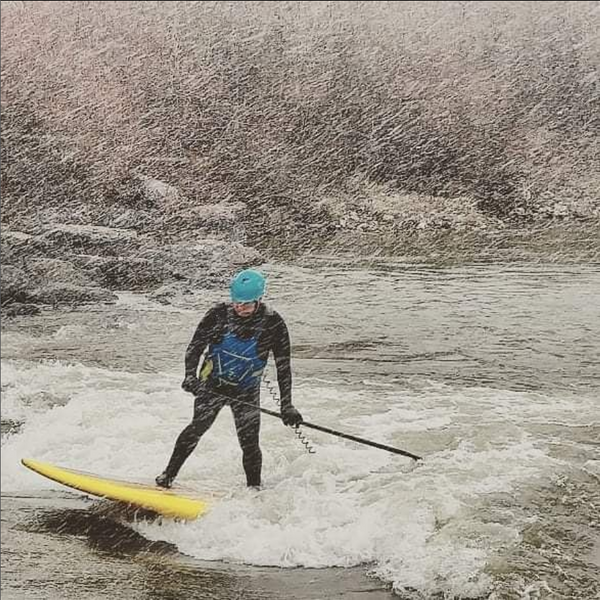
Winter Paddle Boarding Tips: Stay Warm, Safe & Stoked
Make winter SUP safe and magical—dress for immersion, choose calm days, stay near shore, and carry warm fluids. Stable boards, proper leashes, and short sessions keep you warm, confident, and stoked.
Winter paddle boarding is safe and magical with smart choices: pick calm days, dress for immersion (drysuit or thick wetsuit with booties and gloves), wear a PFD and venue-appropriate leash, and paddle familiar, stable boards.
Inflate iSUPs to recommended PSI and recheck in the cold.
Keep routes near shore, maintain steady cadence for warmth, and carry warm fluids plus a compact safety kit.
Change into dry layers immediately post-paddle.
Short sessions deliver big rewards—quiet water, snowy banks, and unforgettable mornings.
Table of contents
Winter paddleboarding might seem a bit daring for some, but here at Glide HQ in SLC, UT, where the temperatures drop and the days grow shorter, we find it absolutely exhilarating. Contrary to what many might think, paddling through the colder months isn't just doable; it's an enchanting experience that borders on magical, especially after a fresh snowfall. For those who've never ventured out on their SUP in winter, imagine the serene beauty of gliding over a silent, snow-covered waterway—it's a scene straight out of a fairy tale.
In this article we give you our very best winter paddle boarding tips.

Embrace Winter Paddleboarding: Tips for a Safe & Magical Experience
Snow on the banks, silence on the water, steam off your breath—it’s a different kind of magic. With the right prep, winter paddle boarding is not only doable, it’s unforgettable. Use this guide to choose the right gear, read winter conditions, and paddle confidently when temps drop.
Read the day right (conditions first)
-
Wind beats cold: Aim for light or no wind; breeze across open water multiplies chill and risk of drift.
-
Watch radar & temps: Avoid rain + cold (hypothermia risk). Snow is fine if winds are calm and visibility is good.
-
Route smart: Choose shore-hugging out-and-backs, short laps, or coves with easy exits. Note daylight—winter sunsets come fast.
Dress for immersion, not ambition
-
Drysuit (best mix of warmth + safety): breathable shell + insulating mid-layers + moisture-wicking base.
-
Wetsuit (great for active paddles/surf): 4/3–5/4 mm with booties (5–7 mm) and gloves (3–5 mm).
-
Head/face: neoprene beanie or hood; buff for wind.
-
Hands & feet tactics: pre-warm gloves/booties indoors; bring a spare dry pair in a drybag.
Safety: non-negotiables
-
PFD on, always: vest-style for constant wear.
-
Leash matched to venue: coiled (flat/open), quick-release waist (current/rivers), straight (surf).
-
Buddy or shore spotter: if solo, leave a float plan + ETA and carry whistle + light.
-
Comms & backup heat: phone in waterproof case, small towel, chemical warmers, lightweight puffy in drybag.
-

Board & setup for winter water
-
Stability first: a familiar, wider all-around (e.g., Glide O2 Retro) keeps knees soft and heart rate low.
-
Inflatable in the cold: inflate to recommended PSI; air pressure drops with temperature—top up at the launch.
-
Deck pad & traction: grippy, full-length pad reduces foot fatigue; add wax/spray if icy.
-
Fin choice: standard dolphin for tracking; shallower river fin for icy shorelines and low water.
Stroke, stance, and pacing that keep you warm
-
Steady cadence > sprint/stop: constant movement keeps warmth without sweaty spikes.
-
Shorter, cleaner strokes: vertical shaft, full catch, exit by your feet to stay efficient in gloves.
-
Soft knees, quiet chest: let ankles/knees do the shock work across wind ripples or slush edges.
Cold-water checklist (bring it, use it)
-
1–2 L warm drink (insulated bottle); electrolytes help in dry winter air.
-
Micro-towel + dry gloves/hat in a drybag.
-
Headlamp or strobe (short daylight).
-
Emergency kit: foil blanket, lighter, fire starter, small first-aid.
-
Spare leash pin/fin screw—winter fingers drop tiny parts.
Post-paddle recovery (protect your session)
-
Change fast: dry base layer, warm hat, puffy/jacket immediately.
-
Warm slowly: hands under armpits; sip warm drink; vehicle heater after you’re dry.
-
Rinse/dry gear: salt and de-icer are rough on zippers, valves, and fabric; hang dry everything.
Simple winter sessions (plug-and-paddle)
-
Shoreline laps (25–40 min): 5–8 min easy loops staying near exits; stop if wind picks up.
-
Cove technique (20–30 min): cadence ladders (60–70–80 SPM) + 2–3 buoy turns each lap.
-
Photo drift (15–20 min): calm snow days—paddle 5, drift 2, repeat; magic without sweat.

Final Thoughts on Winter Paddle Boarding Tips
Winter doesn’t end the season—it edits it. Choose calm days, dress for immersion, keep routes close to shore, and favor familiar, stable boards. The reward is silence, clarity, and those rare mornings when every stroke writes a line across glassy, snow-lined water.
FAQs
Can I use an inflatable SUP in winter?
Yes—just inflate to spec and expect pressure drops in the cold. Top up at launch and check again after 10–15 minutes.
Drysuit or wetsuit?
Drysuit for maximum warmth and safety during low-intensity paddles; wetsuit works for more active efforts or surf. Always add booties and gloves.
What wind is too much?
If whitecaps appear or steady wind exceeds your comfort to paddle into it, skip the day. Cold + wind compounds risk.
Is a leash safe in rivers during winter?
Use a quick-release waist leash in any current; never ankle leashes in moving water.
How long should winter sessions be?
Short and sweet— 20–45 minutes is plenty. You can stack short laps with warmup breaks.





